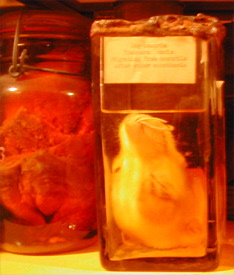
U.S. National Parasite Collection
U.S. Department of Agriculture
Agricultural Research Service
(ARS)
Beltsville Agricultural
Research Center (BARC)
Beltsville, MD
(301) 504-8444
www.lpsi.barc.usda.gov/bnpcu/ |
Most of us consider parasites the lowest form
of life. They feed off other creatures, usually following the food source
straight to the alimentary canal, often settling at its nether end. We
find this exploitative existential condition unforgivably dirty, nasty
and opportunistic, so we turn it into the stuff of horror films: Dracula,
The Tingler, Alien, Cronenberg�s libidinous pseudo-organs in Shivers. These
things get under our skin and eventually snatch our bodies and our minds...making
Pod People wherever they go.
Look at the real parasites--the tapeworms, ticks, flukes,
fleas, and so on--another way, and they can be a case study of life�s marvelous
diversity and determination. Nature�s first law seems to be "find a niche
and fill it," and the parasites just went where no others dared to tread.
The same evolutionary law could apply to scientists. When all the good
stuff is taken, it�s time to take up with parasites. But once you join
the parasitologists, you�ll see how important the bugs they study really
are.
Not surprisingly, the DC area is one of the greatest places
in the world to view parasites--and not just because Congress meets here.
In all seriousness, possibly the world's largest collection of parasites
is housed in nearby Beltsville, Maryland, on the campus of the USDA's Agricultural
Research Service. It�s just another national treasure we�re lucky to have
close by.
The U.S. National Parasite Collection contains approximately
20 million specimens, a number rivaled only by the British Museum. The
specimens are contained in more than 100,000 lots, where a lot is a single
jar or prepared microscope slide. Some jars can contain thousands of tiny
creatures. These numbers don�t include several large specialized collections
and private donations. And the collection as a whole grows at the rate
of 1,000 to 1,500 lots per year.
That's a lot of little uglies, but better here than in
your personal business!
Visiting the Collection
Given the small staff, cramped quarters, and security
gauntlet, the U.S. National Parasite Collection has not been set up to
receive visitors. Casual parasite observers will get an eyeful at the ARS
National Visitor Center, where they can temper the horrors with the glories
of the Log Lodge (and a fungus hat). You can schedule a tour of the BARC
campus by calling the Visitor Center in advance [at 301/504-9403], and
they'll bring you by the main parasite compound. Once in a while, Pat admits,
with advance notice she can accommodate small groups of enthusiastic visitors.
[go to full article] |